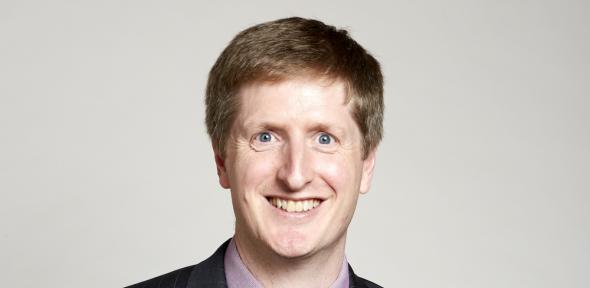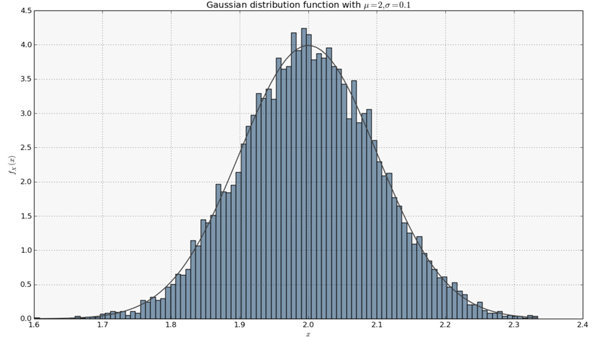
Richard Samworth, Professor of Statistical Science at the Department of Pure Mathematics and Mathematical Statistics (DPMMS) and Director of the Statistical Laboratory, has won two prestigious prizes within 24 hours. One is the David Cox Medal for Statistics and the other is the Guy Medal in Silver.
"Richard's contribution to methodological and theoretical statistics has been truly outstanding, as have his contributions to the statistical profession as a whole," said John Aston, Harding Professor of Statistics in Public Life at DPMMS and President of the Royal Statistical Society. "He is a real supporter of others in the community, having worked tirelessly in mentoring students and researchers. Richard is to be congratulated for his achievements as a role model in the field."
One statistician, two prizes
Both prizes recognise extraordinary contributions to the field of statistics. The David Cox Medal for Statistics commemorates the pioneering statistical work of Sir David Cox in the fields of statistical theory, methodology and applications. Cox, who died in 2022, studied mathematics at Cambridge in the 1940s and later became President of the Royal Statistical Society (RSS) and an Honorary Fellow of St John's College.
Richard's contribution to methodological and theoretical statistics has been truly outstanding, as have his contributions to the statistical profession as a whole. Professor John Aston
Three Cox medals are awarded every three years by the RSS in partnership with the American Statistical Association (ASA), the Bernoulli Society, the International Biometric Society (IBS), the Institute of Mathematical Statistics (IMS) and the International Statistical Institute (ISI). The Cox medals have only recently been established and 2025 is the first year they are being awarded.
Samworth received an inaugural Cox medal for work that is relevant to the majority of the prevailing topics statistics has focussed on over the past two decades. "Richard has been at the forefront from the outset," the citation reads. "In addition to his stellar research contributions, Richard has mentored with distinction many students and young researchers , as well as serving the profession tirelessly through journal editorships and other contributions to multiple statistical societies.
Guy medals are awarded every year by the RSS to fellows of the Society who have made exceptional contributions to the field. The medals are named after the British medical statistician William Augustus Guy. The Bronze and Silver medals are awarded annually and the Gold medal is awarded every two years.
Samworth received the Guy Medal in Silver for outstanding contributions to the development of methodology and theory in various areas of statistics, and for having "gone above and beyond in supporting other members of the profession."
Big data needs new methods
Much of Samworth's work has involved developing new statistical methods, as well as statistical theory, to tackle modern data challenges. "One of the ways the subject has evolved in recent years is in the size of data sets that are routinely collected, in areas like genetics, medical imaging, particle physics, and many others," he told us in a previous interview. "This creates a demand for new techniques, because the traditional ones may be too slow or perform very poorly in this brave new Big Data world."
An example of the type of work Samworth has been doing involves one of the most fundamental questions in statistics: what kind of distribution does a given data set come from? To illustrate this with a very simple example, imagine you want to understand the annual income distribution in a country. Ideally, you would like to draw a curve which tells you, for each possible value of what someone can earn in a year, what proportion of people earn that amount. If you can describe this curve by a neat mathematical formula, then all the better.
To approach this problem you collect data on people's annual income and aim to find the distribution that best fits the data. One way of doing this is to assume that the corresponding curve has a particular pre-determined shape. For example, you might assume the data follows the famous bell shape of the normal distribution, which is described by a nice mathematical formula. The exact location and width of the curve can then be estimated from your data. This is what is called a parametric method because what you are doing is estimating the parameters of a given type of distribution.
"[The parametric approach] is very easy to apply, but the shape of the distribution is highly constrained, and this wouldn't be appropriate for many types of data," said Samworth.

The bell shape of the normal distribution and a histogram representing data that is approximately described by the distribution. Figure Shishirdasika, CC BY-SA 3.0.
Another approach is to draw a histogram. You divide the possible values for annual income up into bands, such as £0-£1,000, then £1,000-£2,000, etc, and count the proportion of people whose income falls into each of these bins. This could capture skewness in the distribution, for instance, but you could end up with quite a different estimate if you changed the width of the bins.
"These non-parametric or smoothing methods are much more flexible in terms of their shape, but tend to leave you with an annoying choice of how much you want to smooth, for example by changing the width of the bins," said Samworth.
Together with colleagues Samworth has developed a method that takes the best of both worlds, called log-concave density estimation, which can be applied to data sets that are a lot more complex than our example. "It's both a flexible method and one that is fully automatic for the practitioner to use, and it's got a beautiful theory associated with it as well."
One of Samworth's papers on the log-concave method, the Guy Medal citation says, "became a landmark providing methodology, elegant theory and efficient computation in shape constrained inference."
Statistical emergencies and hot science
As with the example above, mathematical theory underlies much of Samworth's work. There is, however, also a practical aspect to what he does at the Statistical Laboratory at DPMMS: he runs the Statistics Clinic where anyone from the University of Cambridge can show up with their statistical problem and get advice from a team of experts.
"One of the things I have found interesting since I have set this up is to see just how wide a range of subjects people come from to receive their statistical help," Samworth said. "We get a lot from the life sciences, and I would have expected that. But we also get people from education, or history, or music — pretty much every subject that is being studied at the University. That's really fascinating!"
That music and history should have use of statistics would probably have surprised most people a few years ago. These days, however, we're all aware that pretty much of the information we meet in real life, including music and texts, is nothing but data — lots of it. "In many ways I have been very lucky," said Samworth. "The subject is now much hotter than when I started my career because people have recognised the way in which Big Data can change their lives — from being able to diagnose and treat cancer more effectively to designing algorithms that underpin driverless car technology."
Samworth may modestly credit some of his success to lucky timing in the growing importance of statistics to society, but the two prestigious prizes that he has won reflect his outstanding work and deep commitment to supporting others. Congratulations!
